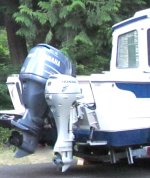thataway":3jpx4zbh said:
I am wondering why folks are using the "Mini Jacker" outboard bracket mount rather than one of the other fixed outboard motor brackets for trolling motors.
I slightly wondered about that myself, but went ahead with the Mini-Jacker for a few reasons:
1) I could see that it had worked well on other 22/Bennett tab setups.
2) My Honda 8D didn't seem to lend itself to being propped up when trailering, and when "down" (and mounted directly on the transom) it was riding too close the the road for comfort. So the 3" rise of the MJ took care of that nicely, and given that it is 8hp, I was advised that the rise in prop height when underway (using it) would probably work out okay. I guess I will find out when I trial it.
3) I needed to choose something so I could move ahead with the inter-related projects (trim tabs, etc.), and I really couldn't find another one I was "sure" about. One issue is that I'm not really familiar with them, having come from either sailing or small skiffs wherein you just mounted the outboard on the transom and went off fishing. So the options weren't clear to me and I may have been searching inferior terms/places.
I'd guess you are right in that there is something better, since what most of us are doing with them doesn't seem to be the typical use. For anyone's reference, here are a couple of the places I looked or contacted when I was shopping:
www.thmarine.com
www.bobsmachine.com
All that said, so far the Mini-Jacker has worked out great for the things I've been able to test. That is...
a) It fit well on the transom
b) it put the motor in a good position for trailering
c) it cleared the trim tabs without a problem and without any special shimming or accommodation
The only thing left to check is that it will be at an effective height for motoring (I know, that seems primary -- but it's the one thing I have not tested yet).

